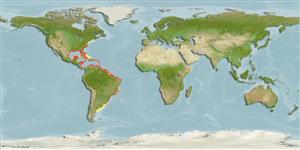Common names from other countries
>
Eupercaria/misc (Various families in series Eupercaria) >
Gerreidae (Mojarras)
Etymology: Eucinostomus: Greek, eu = good + Greek, kyon = dog + Greek, stoma = mouth (Ref. 45335).
More on authors: Quoy & Gaimard.
Environment: milieu / climate zone / depth range / distribution range
Ecologia
marinhas; Água doce; estuarina associadas(os) a recifes; intervalo de profundidade 0 - 55 m (Ref. 26912). Subtropical; 43°N - 51°S, 98°W - 34°W
Western Atlantic: Massachusetts, USA and Bermuda to Argentina; including the Gulf of Mexico and the Caribbean Sea (Ref. 9626).
Length at first maturity / Tamanho / Peso / Idade
Maturity: Lm 11.0 range ? - ? cm
Max length : 25.5 cm TL macho/indeterminado; (Ref. 111768); common length : 15.0 cm TL macho/indeterminado; (Ref. 3722)
Espinhos dorsais (total) : 9; Raios dorsais moles (total) : 10; Espinhos anais: 3; Raios anais moles: 7.
Inhabits shallow waters, being especially abundant over mud bottoms in mangrove-lined lagoons or creeks; larger individuals may also occur on vegetated sand grounds in marine areas. Enters fresh water in limestone regions (Ref. 7251). May occur in aggregations (Ref. 3722). Probably feeds on small benthic invertebrates (Ref. 3722). Marketed fresh but not highly esteemed (Ref. 3722).
Life cycle and mating behavior
Maturities | Reprodução | Spawnings | Egg(s) | Fecundities | Larvas
Robins, C.R. and G.C. Ray, 1986. A field guide to Atlantic coast fishes of North America. Houghton Mifflin Company, Boston, U.S.A. 354 p. (Ref. 7251)
Categoria na Lista Vermelha da IUCN (Ref. 130435)
CITES (Ref. 128078)
Not Evaluated
Ameaça para o homem
Harmless
Utilização humana
Pescarias: pouco comercial; isco: usually
Ferramentas
Relatórios especiais
Descarregue XML
Fontes da internet
Estimates based on models
Preferred temperature (Ref.
115969): 22.8 - 28, mean 25.5 (based on 504 cells).
Phylogenetic diversity index (Ref.
82804): PD
50 = 0.5010 [Uniqueness, from 0.5 = low to 2.0 = high].
Bayesian length-weight: a=0.01096 (0.00924 - 0.01302), b=3.08 (3.04 - 3.12), in cm Total Length, based on LWR estimates for this species (Ref.
93245).
Nível Trófico (Ref.
69278): 2.7 ±0.1 se; based on diet studies.
Resiliência (Ref.
120179): Médio, tempo mínimo de duplicação da população 1,4 - 4,4 anos (K=0.3).
Fishing Vulnerability (Ref.
59153): Low to moderate vulnerability (32 of 100).
